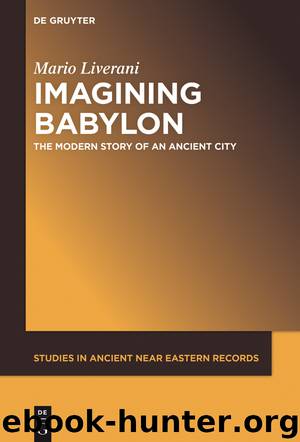Imagining Babylon by Mario Liverani

Author:Mario Liverani
Language: eng
Format: epub
Publisher: Walter de Gruyter
Published: 2016-05-25T16:00:00+00:00
5.11The ‘world-system’ and the expansion of Uruk
Immanuel Wallerstein’s weighty work on the ‘world-system’ was published between 1974 and 1989,1165 and though it was already clear from the title (The Modern World-System) that it was dealing with the modern world, and with the European political-economic expansion into the entire world, the work immediately (right from the first volume) also aroused lively interest on the part of ancient historians, struck by its methodological importance per se, and above all tempted to identify world-systems dating always further back, as far as remotest antiquity. The merits and limitations of this retroactive application to systems that Wallerstein himself did not consider relevant were presented by Philip Kohl in an excellent article,1166 in which the Early Bronze Age was indicated for an advantageous application, when Mesopotamia, Iran, Central Asia, the Indus Valley, and the Gulf area interacted fairly intensely on a broad horizon (cf. § 4.7). In the same book in which Kohl’s article was re-published, Carl Lamberg-Karlovsky also tackled this wide interaction between the various civilizations of south-western Asia of the third millennium.1167 The archaeologist-Indologist Shereen Ratnagar1168 likewise favours application of the ‘world-system’ model to the whole of the Early Bronze Age cultures, an entirety which in effect extends across a very large area (from the Mediterranean to India); while emphasizing (through clear neo-Marxist and Polanyian influence) the differences between a capitalist world-system and possible pre-capitalist systems not centred on the market, she nevertheless proposes the identification of the only world-system of antiquity in the complex of Mesopotamia / the Gulf / Iran / the Indus valley / Central Asia of the third millennium. A less decided position is taken by Maurizio Tosi and his school, who give a certain emphasis inside the system to the diversities, the characteristics peculiar to each component.1169
Authoritative, but in the end too radical, support then comes from Gunder Frank,1170 who – over and above retracing the question of primary and secondary urbanization inside the ‘world-system’, and highlighting that the system includes ecological diversities and exchange of surplus that differ among them – poses questions about the remote origin of the ‘world-system’ and of the existence of only one world-system, or many, or none. For Frank, there is only one world-system, which runs through the whole of world history and which was already in existence at least from 2700 BC, with a ‘centre’ somewhat paradoxically placed in the emptiness of Central Asia in order to connect the Near East and China. Frank’s reasoning (as already said at § 4.4) is that a system exists if component A would be different were it not in a relationship with component B and vice versa. But different how much? A relationship of very long-distance trade, occasional and marginal, means much less on the structural level: the components would develop just as well separately.
Another important aspect (to which the name of Gunder Frank immediately calls attention) is that the existence of a world-system, in the centuries of the modern world and European expansion, entails
Download
This site does not store any files on its server. We only index and link to content provided by other sites. Please contact the content providers to delete copyright contents if any and email us, we'll remove relevant links or contents immediately.
The Five People You Meet in Heaven by Mitch Albom(3515)
The Secret Power of Speaking God's Word by Joyce Meyer(3060)
Real Sex by Lauren F. Winner(2986)
Name Book, The: Over 10,000 Names--Their Meanings, Origins, and Spiritual Significance by Astoria Dorothy(2960)
The Holy Spirit by Billy Graham(2914)
0041152001443424520 .pdf by Unknown(2812)
How The Mind Works by Steven Pinker(2769)
ESV Study Bible by Crossway(2757)
Ancient Worlds by Michael Scott(2647)
Churchill by Paul Johnson(2540)
The Meaning of the Library by unknow(2532)
The ESV Study Bible by Crossway Bibles(2527)
The Gnostic Gospels by Pagels Elaine(2495)
MOSES THE EGYPTIAN by Jan Assmann(2393)
Jesus by Paul Johnson(2330)
City of Stairs by Robert Jackson Bennett(2326)
The Complete Dead Sea Scrolls in English (7th Edition) (Penguin Classics) by Geza Vermes(2254)
Ancient Near Eastern Thought and the Old Testament by John H. Walton(2204)
The Nativity by Geza Vermes(2202)
